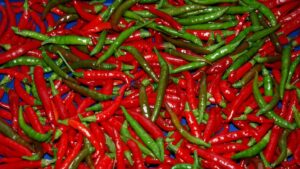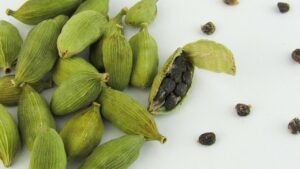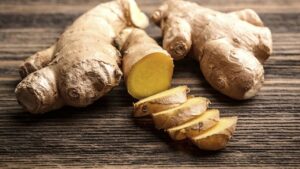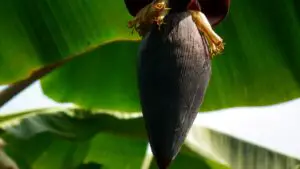Saffron is a popular ingredient in many Indian cuisines, especially those largely influenced by Persian cooking style.
Saffron is called kesar in Hindi. Saffron strands, which are used in cooking, are collected from the flower of Crocus Sativus. The vibrant crimson strands are dried before they are sold in the market.
Saffron is one of the most expensive spices used in cooking. This premium spice is loved for its rich colour, flavour and texture.
Saffron is loaded with medicinal properties. Iran is the largest producer of saffron in the world. Iranian saffron is also the best in quality. Saffron is also cultivated in India, Italy, Greece, Morocco and Spain.
Use of Saffron in Indian Cuisines

Pulao and Biryani
Saffron strands are soaked in lukewarm milk and then it is added to biryani for both colour and flavour.
Saffron is used in a fewer quantity; otherwise, it will overpower any dish for its strong flavour.
Shahi pulao will never look and taste so rich and shahi without saffron. A few strands whip up a great magic!
Saffron brings a royal texture to any dish. So, it’s no surprise that saffron rice will live up to foodies’ expectations.
Saffron does a great job by infusing a yellow colour into rice while adding flavour to each grain.
Kebabs and Curries
This spice infuses a distinct flavour and colour in any rich and royal preparation, from non-veg curries to deserts.
Saffron is almost a must in every Iranian dish. Chelo kebab, which is a famous Persian Iranian dish, has now become a part of the greater culinary culture of our country. Without saffron, the dish will lose half of its flavour and taste.
Saffron is also used in other varieties of kebabs which are actually Persian delicacies that came to India with Mughals.
Shahi raan, lamb leg roast are prepared in saffron raisin sauce. Saffron along with other spices perks up flavours when raisins offer a mild touch of sweetness.
Nawabi keshar kofta has the signature of saffron in its name. Just a pinch of saffron and that’s enough to infuse a luxurious and luscious feel and flavour into koftas cooked in a rich blend of spices and nuts.
Saffron is not usually used in veg delicacies. However, saffron gives a subtle touch of colour and flavour to tandoori paneer tikka.
Deserts
Let us now talk about some deserts and drinks.
Firni, shahi tukda are mouth-watering desserts that use saffron at the end of cooking. Though traditional rice kheer or pudding does not use saffron, one can use this spice for a royal touch in both colour and taste.
Rasmalai is a signature dessert in Bengal. Small rasgullas submerged in saffron-flavoured milk feel soft whereas the bed of chopped dry fruits gives you a crunchy bite. If the look is tempting, the flavour is unforgettable.
Saffron is also used in baking. Breads and cakes, which use saffron, taste more delicious
What are common to kesar peda, mawa kesar roll and kesar shrikhand? All these deserts have saffron in them. Saffron is also used in preparing motichoor ladoo, which is one of the most traditional Diwali Specials.
Saffron is also used in many ice cream recipes. Come summer and kesariya kulfi will give you a ‘thanda thanda’ feel while meeting your sweet craving. Mango kesar kulfi brings the double delights – juiciness of mango and flavour of saffron.
Drinks
In Kashmir, saffron is used to flavour one particular type of tea. It tastes best in chilly mornings and evenings.
Panha, a comforting drink made with raw mango, is lightly but aesthetically flavoured with saffron.
How Does Saffron Taste?
Saffron has a distinctive flavor that is often described as floral, honey-like, and slightly bitter.
It has a delicate, earthy, and slightly sweet taste with a subtle aroma that is difficult to replicate.
The flavor of saffron is highly concentrated, so it should be used sparingly to avoid overpowering other flavors in a dish.
Saffron is a popular spice in many Middle Eastern, Indian, and Mediterranean cuisines, and it is often used to add color, flavor, and aroma to dishes like biryanis, paellas, and risottos.
When Should Saffron Be Added to a Recipe?
Saffron should be added to a recipe at the appropriate time to ensure that its flavor, aroma, and color are fully incorporated into the dish.
Generally, saffron needs to be steeped in a warm liquid such as water, milk, or broth for 15-20 minutes before it can be added to a recipe.
This allows the saffron’s flavor and color to be extracted and infused into the liquid.
Saffron can be added to a recipe at different stages depending on the type of dish being prepared.
For example, if you are making a rice dish such as Pulao, the saffron should be added towards the end of the cooking process when the rice is nearly done.
If you are making a soup or stew, the saffron can be added earlier in the cooking process so that the flavors have more time to meld together.
It’s important to note that saffron should be used sparingly in recipes as it is a potent spice.
A little goes a long way, so it’s best to start with a small amount and add more as needed to achieve the desired flavor and color.
Is Saffron a Spice or Seasoning?
Saffron is generally considered a spice because it is derived from the dried stigmas of the crocus flower and is used to add flavor, color, and aroma to food.
Seasonings, on the other hand, typically refer to a blend of spices or herbs that are used to enhance the flavor of a dish.
While saffron is sometimes used in combination with other spices or seasonings, it is typically used on its own as a spice.
Does Saffron Need to Be Soaked?
Saffron doesn’t necessarily need to be soaked, but it’s often recommended to release its flavor and color.
Soaking saffron in a small amount of liquid, such as hot water or warm milk, helps to extract its flavor and color compounds and distributes them evenly throughout the dish.
This process also helps to soften the saffron threads, making it easier to mix into the recipe.
The length of soaking time depends on the recipe and the desired intensity of saffron flavor and color.
In general, it’s best to soak saffron for at least 15-20 minutes before using it in a recipe. Some recipes may require longer soaking times, up to an hour or more.
If you’re in a rush, you can crush the saffron threads before soaking them to speed up the process.
Alternatively, you can add the saffron threads directly to the recipe without soaking, but you may not get the same depth of flavor or color.
Questions & Answers:
How Much Saffron Do You Cook With?
Two to three threads of saffron are being used in a single dish. You can use max 6 strands when you are making large quantities.
Are Turmeric and Saffron the Same Thing?
Turmeric and saffron looks similar to the bold/vibrant yellow color as the end product of it and both are used as spices. but other than that both turmeric and saffron are different.
How Spicy is Saffron?
Saffron is not a particularly spicy spice. It has a distinct flavor that is slightly bitter and floral with a hint of sweetness.
Should You Crush Saffron?
If you want then you can crush the saffron; otherwise it is not used as for Indian dishes; all are used in the form of saffron strands.
Can You Add Saffron to Anything?
From milk to meat, you can add saffron everywhere to make the food much more aromatic and flavorful.
What is Saffron Called in Different Languages?
Saffron is known as Zafran in Bengali and Kesar in Hindi.
Conclusion
Saffron is a highly valued and versatile spice that is used in a wide range of dishes, desserts, and drinks, particularly in Indian and Middle Eastern cuisines.
Saffron has a unique floral, honey-like, and slightly bitter taste with a delicate, earthy, and slightly sweet flavor that can be difficult to replicate.
Saffron strands are soaked in lukewarm milk before being added to dishes for both color and flavor.
Iranian saffron is considered the best in quality, but it is also cultivated in other countries such as India, Italy, Greece, Morocco, and Spain.
Overall, saffron is a premium spice that adds a touch of luxury and royalty to any dish.







